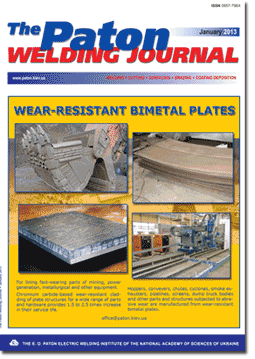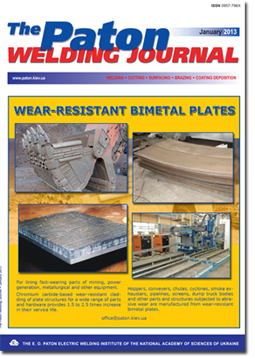| 2013 №01 (09) | 2013 №01 (01) |

The Paton Welding Journal, 2013, #1, 47-51 pages
INCREASE OF FATIGUE LIFE OF WELDED T-JOINTS WITH LACK OF ROOT PENETRATION USING HIGH-FREQUENCY MECHANICAL PEENING
S.A. SOLOVEJ
E.O. Paton Electric Welding Institute, NASU, Kiev, Ukraine
Abstract
Represented are the results of fatigue tests of welded T-joints from low-alloyed steels 09G2S, 10KhSND and 15KhSND. Manufacture of such joints embedded a structural lack of root penetration of 3 x 3 mm cross section along the whole length of the welded joint. The purpose of present study is an experimental evaluation of effect of extensive lacks-of-penetration on fatigue life of the welded joints on low-alloyed steels strengthened by high-frequency mechanical peening which used in manufacture of critical welded metal structures. Testing of welded specimens was carried out with zero-to-tension stress cycle at 5Hz frequency. It is shown that the fatigue life of high-loaded T-joints from low-alloyed steels strengthened by given technology and containing extensive structural lacks of root penetration of 3 x 3 mm cross section, is in a range of spread of experimental data for strengthened welded joints made with full penetration. Failure of the specimens at that takes place from the lack of root penetration along the rib and their fatigue life rises up to 10 times in comparison with that of unstrengthened specimens with full penetration. As was stated, the presence of structural lack-of-penetration in the unstrengthened high-loaded T-joints, cross ribs of which do not transfer main load, provides no effect on the fatigue life since formation and propagation of cracks take place on zone of weld metal to base metal transfer. 13 Ref., 4 Figures.
Keywords: welded metal structures, low-alloyed steels, T-joint, fatigue life, high-frequency mechanical peening, fatigue
Received: 14.11.12
Published: 28.01.12
References
1. Trufyakov, V.I. (1973) Fatigue of welded joints. Kiev: Naukova Dumka.
2. (1990) Strength of welded joints under alternating loadings. Ed. by V.I. Trufyakov. Kiev: Naukova Dumka.
3. Trufyakov, V.I., Kyrian, V.I., Knysh, V.V. et al. (1988) Carrying capacity of welded joints with technological defects: Manual. Moscow: Mashinostroenie.
4. Xiaohui Zhao, Dongpo Wang, Lixing Huo (2011) Analysis of the S-N curves of welded joints enhanced by ultrasonic peening treatment. Materials & Design, 32(1), 88-96.
5. Abston, S. (2010) The technology and applications of ultrasonic impact technology. Austral. Welding J., 55, 20-21.
6. Danqing Yin, Dongpo Wand, Hongyang Jing et al. (2010) The effects of ultrasonic peening treatment on the ultra-long life fatigue behavior of welded joints. Materials & Design, 31(7), 3299-3307.
7. Marquis, G. (2010) Failure modes and fatigue strength of improved HSS welds. Eng. Fract. Mech., 77, 2051-2062.
8. Kudryavtsev, Y., Kleiman, J., Lugovskoy, A. et al. (2007) Rehabilitation and repair of welded elements and structures by ultrasonic peening. Welding in the World, 51(7/8), 47-53.
9. Kuhlmann, U., Durr, A., Gunther, P. et al. (2005) Verlaengerung der Lebensdauer von Schweisskonstruktion aus hoeherfesten Baustaehlen durch Anwendung der UIT-Technologie. Schweissen und Schneiden, 57(8), 384-391.
10. Knysh, V.V., Valteris, I.I., Kuzmenko, A.Z. et al. (2008) Corrosion fatigue resistance of welded joints strengthened by high-frequency mechanical peening. The Paton Welding J., 4, 2-4.
11. Knysh, V.V., Solovej, S.A., Kuzmenko, A.Z. (2008) Accumulation of fatigue damage in tee welded joints of 09G2S steel in the initial condition and after strengthening by high-frequency mechanical peening. Ibid., 10, 10-15.
12. Knysh, V.V., Kuzmenko, O.Z., Solovej, S.O. (2009) Accumulation of fatigue damage in tee welded joints in initial condition and after strengthening by high-frequency mechanical peening under block loading. Mashynoznavstvo, 9, 27-31.
13. Troshchenko, V.T., Sosnovsky, L.A. (1987) Fatigue resistance of metals and alloys: Refer. Book. Pt 1. Kiev: Naukova Dumka.
Suggested Citation
S.A. SOLOVEJ (2013) INCREASE OF FATIGUE LIFE OF WELDED T-JOINTS WITH LACK OF ROOT PENETRATION USING HIGH-FREQUENCY MECHANICAL PEENING. The Paton Welding J., 01, 47-51.The cost of subscription/purchase order journals or individual articles
| Journal/Currency | Annual Set | 1 issue printed |
1 issue |
one article |
| TPWJ/USD | 384 $ | 32 $ | 26 $ | 13 $ |
| TPWJ/EUR | 348 € | 29 € | 24 € | 12 € |
| TPWJ/UAH | 7200 UAH | 600 UAH | 600 UAH | 280 UAH |
| AS/UAH | 1800 UAH | 300 UAH | 300 UAH | 150 UAH |
| AS/USD | 192 $ | 32 $ | 26 $ | 13 $ |
| AS/EUR | 180 € | 30 € | 25 € | 12 € |
| SEM/UAH | 1200 UAH | 300 UAH | 300 UAH | 150 UAH |
| SEM/USD | 128 $ | 32 $ | 26 $ | 13 $ |
| SEM/EUR | 120 € | 30 € | 25 € | 12 € |
| TDNK/UAH | 1200 UAH | 300 UAH | 300 UAH | 150 UAH |
| TDNK/USD | 128 $ | 32 $ | 26 $ | 13 $ |
| TDNK/EUR | 120 € | 30 € | 25 € | 15 € |
AS = «Automatic Welding» - 6 issues per year;
TPWJ = «PATON WELDING JOURNAL» - 12 issues per year;
SEM = «Electrometallurgy Today» - 4 issues per year;
TDNK = «Technical Diagnostics and Non-Destructive Testing» - 4 issues per year.


